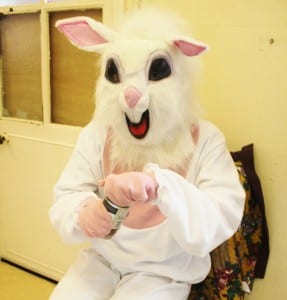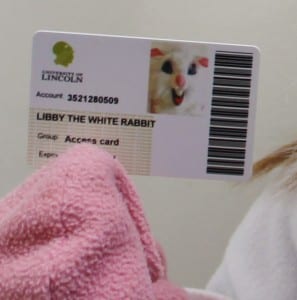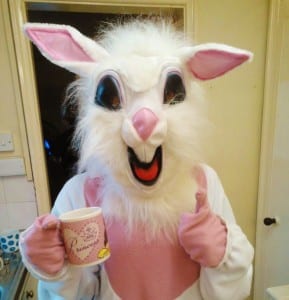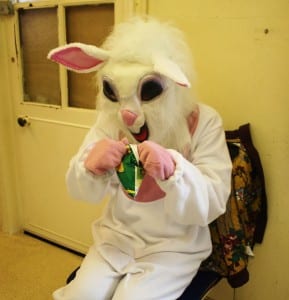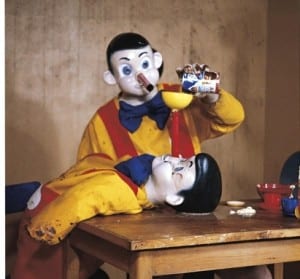“ We’ve always been interested in the idea of a speech, a formal utterance: the framing of something – ‘I have come to tell you this,’ or ‘I am about to tell you this.’” ((Williams, David and Carl Lavery (2011) Good Luck Everybody: Lone Twin: Journeys, Performances, Conversations, Wales: Cambrian Printers, p.203))
‘Hello, my name is Libby and I have been a white rabbit since the 19th of February, which is 76 days today! Welcome to the kitchen, can I get you a drink?’ This is how I began my performance; simple and direct. Because it is very simple: I dress as a rabbit and get filmed doing everyday normal tasks. Some people laugh at me, some people take photos. Some children stare at me, some children cry. I always get a reaction though, whatever it is.
The Safe House was a project that generated a lot of different audience reactions from the various activities and happenings that took place in each room. The outcome I very much wanted to achieve from my performance was to initially shock the audience, because, quite frankly, you wouldn’t expect a giant rabbit to burst into your living room every day! I wanted this mood to quickly change however when they entered the kitchen and realised; I am Libby who just so happens to be wearing a white rabbit costume, discussing my many adventures over a cup of tea and a bag of sweets.
Photo taken: 01/03/2013 – ‘The Impossible Tasks’
“On the other hand, there are signs that theatre can provide meaningful forms of audience participation and engagement.” ((Freshwater, Helen (2009) theatre and audience, Hampshire: Palgrave Macmillan, p.76))
With my performance being conversational, in some respect, my audience had a role to play. Without their contribution, their questions and opinions, my performance wouldn’t be as enjoyable and therefore I wanted them to open up and relax in order to fully engage with my performance. Luckily, all of them did (some more than others) and mentioned how they enjoyed being in the space, even commenting that they didn’t want to leave!
Over the 76 days of being dressed as a rabbit, I have collected feedback and reactions from my different audiences through film and documentation. For my performance I wrote out some phrases (with my bunny hands), quoting my audience’s reactions and hung them on the wall. Over the performance period I carried on collecting and added to my list the ones I found the most interesting. ‘You’re a very lovely bunny’ and ‘When you came crashing in, it just shit me up!’ were two of my favourite!
Site specific performance has opened up a whole new world of theatre to me, a world that pushes boundaries and that exceeded all expectations I first had. It has been a challenging process, but one I will never forget and definitely carry on with in the future. My only regret is not completing all the impossible tasks I hoped to achieve, going through passport control being just one. Somehow I don’t think my bunny days are over just yet!
